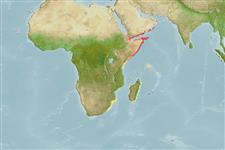Common names from other countries
Holocephali (quimeras) (chimaeras) >
Chimaeriformes (Chimaeras) >
Rhinochimaeridae (Longnose chimaeras)
Etymology: Neoharriotta: neo-, from neos (Gr.), new, i.e., a new genus related to Harriotta. (See ETYFish); pumila: Latin for dwarf, referring to its small size at maturity, “making it an apparent dwarf among chimaeroids”. (See ETYFish).
Environment: milieu / climate zone / depth range / distribution range
Ecologia
marinhas batidemersal; intervalo de profundidade ? - 380 m (Ref. 58018). Deep-water
Western Indian Ocean: slope waters off Somalia and Socotra Island.
Tamanho / Peso / Idade
Maturity: Lm ? range ? - ? cm
Max length : 72.8 cm TL macho/indeterminado; (Ref. 26786)
Oviparous (Ref. 205). Eggs are encased in horny shells (Ref. 205).
Life cycle and mating behavior
Maturities | Reprodução | Spawnings | Egg(s) | Fecundities | Larvas
Didier, D.A. and M. Stehmann, 1996. Neoharriotta pumila, a new species of longnose chimaera from the northwestern Indian Ocean (Pisces, Holocephali, Rhinochimaeridae). Copeia 1996(4):955-965. (Ref. 26786)
Categoria na Lista Vermelha da IUCN (Ref. 130435)
CITES (Ref. 128078)
Not Evaluated
Ameaça para o homem
Harmless
Utilização humana
Ferramentas
Relatórios especiais
Descarregue XML
Fontes da internet
Estimates based on models
Preferred temperature (Ref.
115969): 11.8 - 16.5, mean 13.9 (based on 5 cells).
Phylogenetic diversity index (Ref.
82804): PD
50 = 0.6289 [Uniqueness, from 0.5 = low to 2.0 = high].
Bayesian length-weight: a=0.00195 (0.00083 - 0.00458), b=3.15 (2.95 - 3.35), in cm Total Length, based on LWR estimates for this (Sub)family-body shape (Ref.
93245).
Nível Trófico (Ref.
69278): 3.7 ±0.5 se; based on size and trophs of closest relatives
Resiliência (Ref.
120179): Baixo, tempo mínimo de duplicação da população 4,5 - 14 anos (Assuming Fec <100).
Fishing Vulnerability (Ref.
59153): Moderate to high vulnerability (49 of 100).
